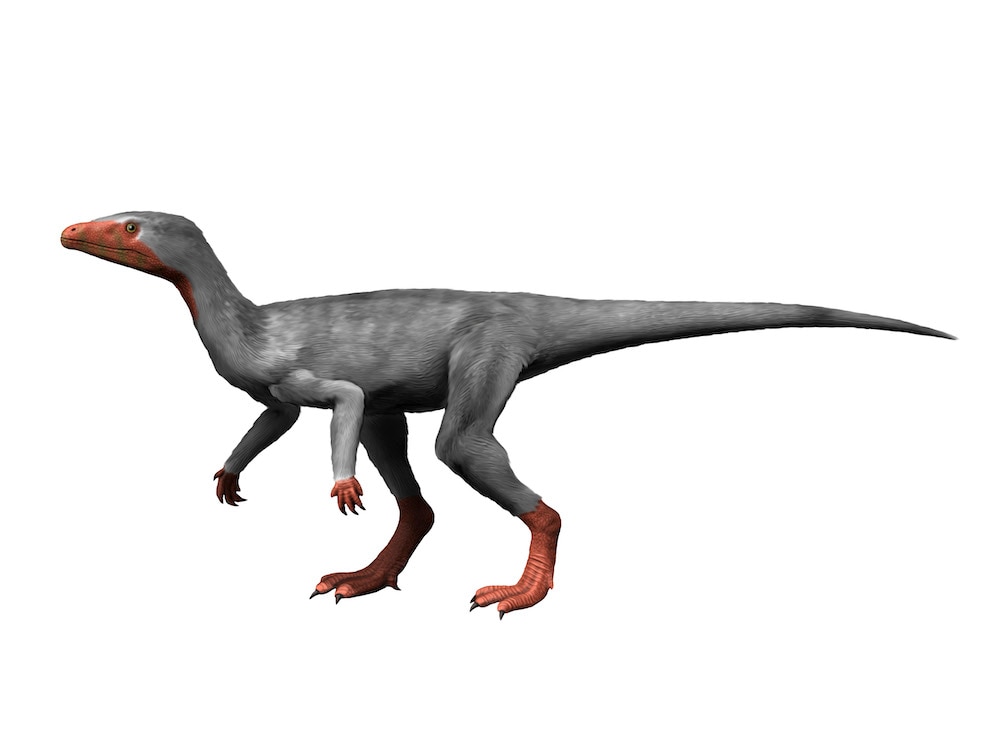Create a free profile to get unlimited access to exclusive videos, sweepstakes, and more!
Feather coats may have helped the dinosaurs survive an apocalypse
How to survive when the springtime of your species is over.

There’s a reason that the theme parks of Jurassic Park and Jurassic World are filled with lush green expanses punctuated by the occasional scientifically resurrected animal. When we imagine dinosaurs, we like to envision them as having inhabited something akin to the modern rainforest. Plenty of foliage to be trampled beneath the feet of a rampaging Tyrannosaurus rex.
We have a much harder time imagining dinosaurs traipsing through snow and ice, but it turns out that might be a simple failing of our imaginations. Recent research suggests that dinosaurs in the Late Triassic might have been well adapted to living in colder climates, including those with freezing temperatures, and those adaptations might even have been the reason they survived the mass extinction 202 million years ago.
Paul Olsen, from the Lamont-Doherty Earth Observatory at Columbia University, and colleagues, made a new analysis of debris in Late Triassic lakes and found evidence of ice alongside evidence of dinosaurs. They concluded that the likely reason dinosaurs survived while so many of their contemporaries didn’t comes down to the presence of their feathery coats. Their findings were published in the journal Science Advances.
While the Cretaceous extinction was caused by a fluke rendezvous between our planet and a cosmic impactor, the Triassic extinction was much more down to Earth. A series of volcanic eruptions dumped massive amounts of gases into the atmosphere, rapidly cooling the surface of the planet and grinding the machinery of life nearly to a standstill.
“Volcanic eruptions release carbon dioxide and sulfur dioxide. Carbon dioxide warms the planet but when sulfur dioxide is thrown into the atmosphere it produces sulfuric acid which is extremely reflective to light. They produce two diametrically opposed results, but they operate on totally different timescales,” Olsen told SYFY WIRE.
Carbon dioxide takes a comparatively long time to make its way out of the atmosphere. After the eruptions, it took approximately 400,000 years before CO2 levels dropped back to their base level. By contrast, sulfur dioxide dissipates in approximately five years after it stops being dumped into the atmosphere. Five years of reduced light and colder temperatures is plenty of time to throw a wrench into the livelihood of any species not suitably adapted, but the real trouble came from the extended eruption period.
We can get a glimpse of what it might have been like, by looking at our own history. The Laki eruptions, which occurred between 1783 and 1784 released approximately 15 cubic kilometers of lava, and for every bit of lava there was a corresponding release of carbon dioxide and sulfur dioxide. That eruption shrouded large parts of the world in darkness, causing crop failures and countless deaths, but it paled in comparison to the Triassic eruptions. A single measured Triassic eruption dumped at least 2,400 cubic kilometers of lava onto the Earth’s surface, more than 150 times that of Laki.
Assuming the amount of sulfuric acid produced is proportional to the volume of lava released, the effects would have been staggering. Moreover, if the eruption happened over an extended period of years or decades, instead of months, then the loading of sulfuric acid into the environment would have also been extended, resulting in a long-lasting volcanic winter. That dinosaurs survived through this real-world apocalypse tells us they must have been adapted to cold temperatures and their feathers were the likely cause.
“If we take all birds, including ground birds like ostriches, cassowaries, and emus, as well as penguins and other flightless birds, we see that they all have feathers. The fundamental purpose of feathers in those animals is insulation. Insulation is also what allows birds to fly to heights. It’s cold up there, if you’re going to be relatively small and go up to high altitudes, you’re going to freeze. The insulation helps birds as much in flying as it does in penguins,” Olsen said.
Scientists argue then that the fundamental evolutionary benefit of feathers is in keeping animals warm, with flight being only a secondary adaptation which came later. They further argue that dinosaurs must already have been adapted to cold weather, perhaps even living in environments with seasonal winters, in advance of the Triassic extinction. Then, when the volcanic winters came, they were able to move south and deal with the colder temperatures.
Their competitors, on the other hand, the uninsulated reptiles more closely related to crocodiles had already adapted to the warmest places on the planet, and when the world got colder, they had nowhere to go. They died out and the surviving dinosaurs were able to move into the niches they left behind.
The Triassic dinosaurs are the perfect evolutionary evidence that if you want to survive a changing world in moderate comfort, it’s always best to carry a down jacket.


























